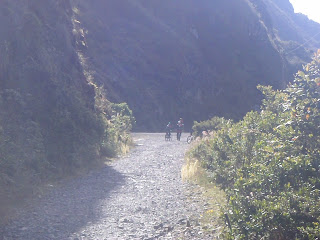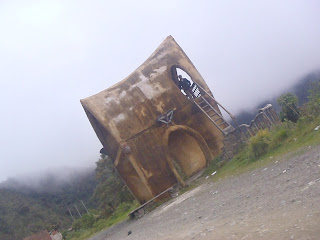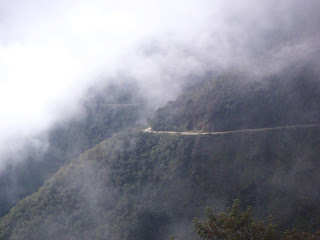Memorial Day weekend we were in La Paz, the second largest city in Bolivia. I will post some of the pictures I took and tell you more about "my" part of the trip next week. For today, I want you to see pictures of Farron's 40-mile bike ride on "The Death Road" (El camino de la muerte). Here are just some of the 200+ pictures taken by the tour company and given to us on a CD.
First, the group at the beginning of the day. The guide is the one at center left in the purple jacket. He is giving them their instructions. (Incidentally, Farron said this guy was probably the best biker he has ever seen.)
Among other things, each one of them was given a bottle of alcohol which they poured out as a "libation to the earth". (?!)
Here they are ready to start their adventure. Notice how heavily dressed they are. The jackets and pants were some kind of semi-flexible canvas -- to protect against the cold as well as injury. As soon as he warmed up, Farron took off the pants and then a little later, the jacket. They were just too heavy. He biked most of the way in jeans.
I'm going to insert some of Farron's journal entry here, so you know what you're seeing and some background on this road and ride.
First off, one of the temple missionaries had
read about this bike ride and asked if anyone wanted to try it. Having ridden in the hills and mountains
above La Verne I wanted to give it a try and joined in with 6 other
missionaries plus the Temple President and his wife. As it turned out, I was the most experienced dirt bike rider of
the group. That said, you can guess that
the rest went from "some" experience to a little. Several people admitted to not having ridden
for years.
Let me give a little
history of this road . . . Construction was started during the Bolivian
and Paraguayan War and it was finished in 1930.
Some 7,000 captive Paraguayan solders worked for years to build the
road. It is a transportation link
between the Amazon jungle and the rest of Bolivia. The road was originally 1 lane wide with some
wider spots for passing. It is still
mostly 1 lane but there are a lot of turn-outs so faster traffic can pass.
Traffic rules are
changed on this road. The downhill
driver never has the right of way and must move to the outer edge of
the road. This forces the faster
downhill vehicle to stop so that passing can be negotiated safely. Additionally, unlike the rest of Bolivia,
vehicles coming up are required to drive on the left side of the road, to give the driver
a better view of the vehicle's outside wheel and make passing safer. Believe me, looking down the cliff and/or
mountainside encourages safe practices.
It is a long way to the bottom.
In 2007 a newer road was
built. The new road is paved, has
drainage ditches and piping installed and provides a safer route for the
traffic. Until the new road was built,
the average was 200-300 vehicles on the old road. Having said that, the day we made our bike
ride, the new road was shut down so we met and passed a number of
vehicles. By looking ahead, we generally
could see oncoming traffic. This allowed
us to find wide spots and stop when being passed. This helped take some pressure off as riding
past these vehicles would put the biker on the road edge with the wheels in
loose gravel. Some of the drops are
3,000 feet! Nevertheless, the Death Road remains dangerous. At least 18 cyclists have died on the ride
since 1998. Our guide told us that
during the last 6 months, 4 people have gone over the edge. Three of them were taking pictures and backed
off the road. STUPID!!! Fortunately, they picked places where
underbrush stopped them within the first 50-60 yards. The fourth person rode the bike off the road
and was in a coma for 6 weeks. Don’t
know if she died or not.
The ride is 40 miles
long and takes 4 to 5 hours to complete.
The ride starts just before La Cumbre Pass not far from La Paz, on a
paved road (part of the new road). There
was snow at the side of the road when we left and icicles on the north side of the
stone mountain sides when we returned.
The elevation at the top of the pass is 15,400 feet. The ride is on the paved road for about 4-5
miles. This section allows bikers time
to become accustomed to their bikes, including the BRAKES. I am sure we were hitting 35 miles per hour
and could have gone a lot faster if not for the corners and the cars. As a point of interest, the posted speed
limit was 35 kilometers per hour or about 21 miles per hour. The bike ride ended at a little town called
Corioco at an elevation of 3,600 feet in the steaming Amazonian Jungle. The bikes were great; front and rear
suspension (soft tail) with hydraulic disk brakes. Current price for a new one is around $2,500
and yes, we had to sign papers stating we would replace the bike if it was
damaged due to stupidity. The tour
company takes care to stop everyone about every 14 kilometers. This gives everyone time to rest, get a much
needed drink and snacks. As the hands
never come off the brakes, the down time is very helpful for resting those
muscles.
Here's the view as they started out on the paved road. Notice the snow on the mountains. Cold!
Everyone's still in their heavy gear. Farron was second in line when they started (he's in the white helmet), but as soon as he realized he was the most experienced dirt-bike-rider in the group, he got out in front and stayed there (easier to see and less chance of an inexperienced rider running into him. The others had a distressing - and unsafe - habit of riding too close together, even side by side occasionally, which was not wise.) The guy in the yellow jacket was not part of their group; I guess he was doing the ride by himself or something.
Here he is out in front. You'll notice he has shed all the heavy gear and is wearing only his light jacket (over a T-shirt) and the jeans he always intended to ride in.
This is a place where a bus went over (last year, I think). Not sure how bad the injuries were.
This is Farron, from the switchback above. You'll notice none of the other riders are close.
This is an indigena (native woman) and her daughter that he passed. People DO live up in these hills and they have no way to get anywhere but on foot.
This is an example of the super-rocky road they were on most of the day. Dawn Hurst said she thought she bruised her tailbone from all the bumping over these rocks.
One of the places where a vehicle went over and some people died - marked now by crosses. There were several places on the road like this.
Looking down, near the beginning of the ride.
This monument marks where five insurgents (opponents of the government at the time) were executed by being thrown over the cliff. I don't know if the marker is to commemorate the bravery of the rebels or to warn the people not to try protesting against the government!
This is a monument to the coco leaf. Supposedly it resembles said leaf, but I can't see how. Anyway, coca tea is a big product up here because it supposedly helps with altitude sickness. Plus of course it has many other uses.
This is Farron at one of the rest stops about 2/3 of the way down the road.
This is, to me, the scariest sight of the trip. Talk about a sheer drop! This is one of the places where it's 3,000 feet to the bottom. The van is the one that followed them all the way, equipped with bandages, water, food, their change of clothing for the end of the trip, and a couple of extra bikes on top.
The next four pictures are all views of the road, so you can see just how twisty and narrow it is. It's hard to believe not only cars but also busses and trucks used to navigate this road daily. Yikes! No wonder there were so many fatalities. Here's some more of Farron's journal to explain better . . .
Back
in 2010, Gravity Bolivia, the company we went with, wrote the following
information about this ride. “It has become an extreme sport like bungee
jumping and skydiving. The difference
here is that there is no expert guide controlling your propulsion. You are on
your own. There are no official figures
for the number of deaths but the first tour company to offer the ride says 18
backpackers have been killed since cyclists began tackling its hairpin bends 12
years ago. Other tour companies estimate the figure is slightly lower or higher
than that."
"During the rainy season, from December to
March," our guide said, "Gravity discourages people with little or no experience from
taking part. Although only one rider
with Gravity has had a fatal accident - a man in his 50s about two years ago -
there are plenty of cuts and bruises. Roughly every fortnight, someone requires
hospital treatment for an injury.” I
believe most of these accidents are with other companies that do not provide
the quality of equipment or instruction that we had.
All in all, the bike
ride was breathtaking. As I was in front
and maybe pushing it a little, there wasn’t time to take in much of the amazing
scenery. The road was rough. But as long
as I stayed in the wheel tracks, there were almost no loose rocks. We made the ride during the dry period of the
year and that helped. I would not have
wanted to tackle it during the rainy season.
It was bad enough riding through the water falls and the resulting muddy
road without having the entire road wet.
The rough road, the cornering and the constant need to keep control of
the speed was enough to make me pay attention.
I loved the disc brakes but it was impossible to stop fast because the
road was so steep and rocky.
"There were several times the clouds rolled in
around us. It never got thick enough to
cause us problems."
This is one of the waterfalls beside/through which they rode.
With the care and suggestions made and given by the tour company, and in spite of the inexperience of our group, we only had 4 that hit the ground and one of those would not have gone down if he hadn’t been following a very inexperienced rider as she attempted to ride through this stream. He wound up falling on top of her.
Here we are at the end of the ride, for the most part all in one piece.
One of the perks of the ride is a free beer at the end. Obviously they had to find something else for our group (which probably set a 5th record, come to think of it) - so we got soda. Left to right: Eldon and Dawn Hurst; Bill Johnson (standing); Lynn Crayk, Lee Crayk (Temple President), Bob Cardon, Diana Crayk, Connie Crayk (Temple Matron), and me (complete with pirate patch and bandana!)
They also got a free T-shirt. Eldon's wearing his in the picture above. Here's the logo on the back of the shirt:
The circular white logo is the company motto: gravity assisted mountain biking. I guess when you have to ride the brakes for most of 40 miles, you could say it is a "gravity-assisted" ride.
Farron says if any of you want to come and visit, he'll do it again and take you along!



























Wow! I'd be scared stiff to do that. Way to go Grandpa! I'm so glad it was such a great experience for you. :-)
ReplyDeleteSorry I haven't posted on the blog recently. This is my first time looking at it in a couple of weeks. 8(
ReplyDeleteDad - I'm not sure if you know but Jayda and I have taken up cycling and are loving it! I don't have a lot of time so I focus on going only 30-40 minutes a few days a week in the evenings, and then on Saturday Jayda and I go for about an hour or a little more. Jayda goes for about an hour a day a few days a week. It's a blast and is a great way to not only get exercise but get outside and see and smell all the awesome nature.
I think doing that cycling trip you went on would be a blast! I wish I could've gone with you all, though it did look a bit frightening. What Jayda and I do is pretty much level with only slight fluctuations in elevation. What you did? That's a whole nother thing. I was quite impressed as I read your account of the trip. It's pretty awesome to know that you fared so well compared to everyone else. That's what comes from all the cycling you've done over the years! AWESOME!!!